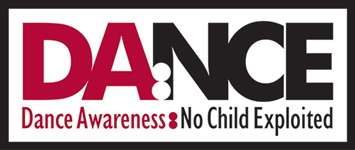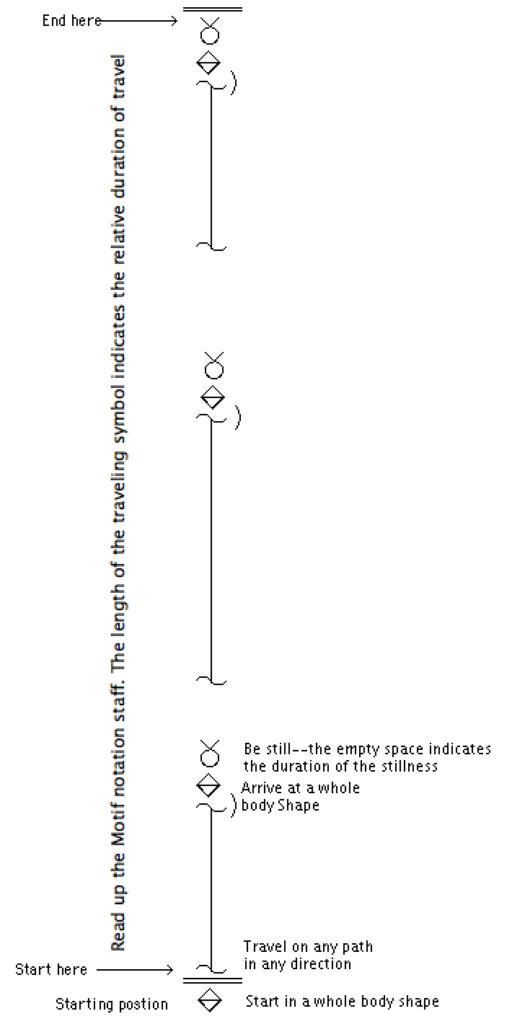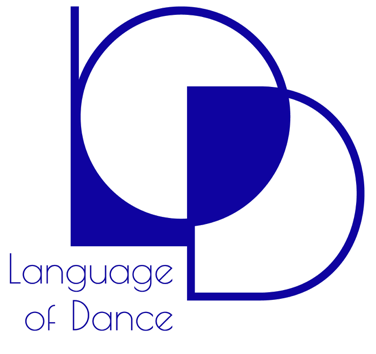 by Susan Gingrasso, MA, CMA, LOD Teacher Trainer Associate Director of the LODC
by Susan Gingrasso, MA, CMA, LOD Teacher Trainer Associate Director of the LODC
What if children had an “alphabet” of movement concepts to explore, experience, and build their understanding of themselves as movers, as creators? What if this “alphabet” guided children to think, do, and feel their own movement fully – to develop their ownership of and agency over their movement choices? What if this approach to learning, performing, and communicating through movement was playful and generative?
Language of Dance® does each of these – and more. Developed by Dr. Ann Hutchinson Guest, world renowned expert in dance notation, preeminent author and researcher on dance, Language of Dance (LOD) is a theoretical and pedagogical framework comprised of
- A conceptual framework based upon the Movement Alphabet, the prime actions of which all human movement is
- A dance discipline-based language that uses symbols to graphically represent and record movement known as Motif
- A pedagogy that integrates the physical experience of moving with cognitive and affective understanding through sensing, observing, reflecting, identifying, interpreting, notating, and creating (Heiland 2020).
- A set of beliefs and values centered in whole-child dancing, community and connection, diversity of application, and embodied meaning
WHAT IS THE LOD MOVEMENT ALPHABET?
The Movement Alphabet is comprised of 14 verbs and two concepts, which result from the action of a verb.
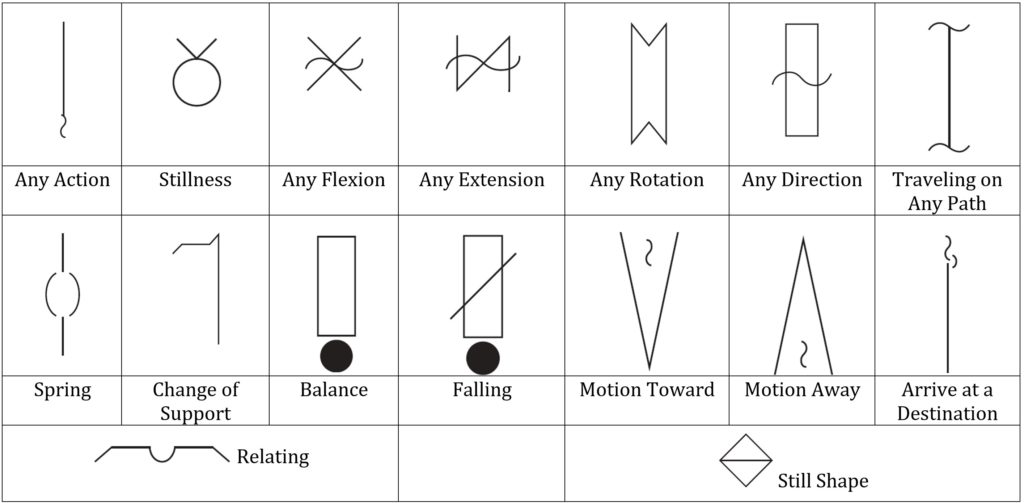
ORIGINS OF THE LANGUAGE OF DANCE
How did Dr. Guest uncover the prime actions of which all human movement is comprised? She sought answers to problems she had discovered while using Labanotation, the structured form of movement notation, while teaching children’s dance in the 1950s at the 92nd Street Y in New York City. She had been experimenting
with Labanotation to teach children to explore and be creative with movement. She discovered that the physical coordination and focus required by structured notation limited their freedom to move and be creative. This experience inspired her to research and identify the prime actions universal to all movement forms (Origins locsusa.org).
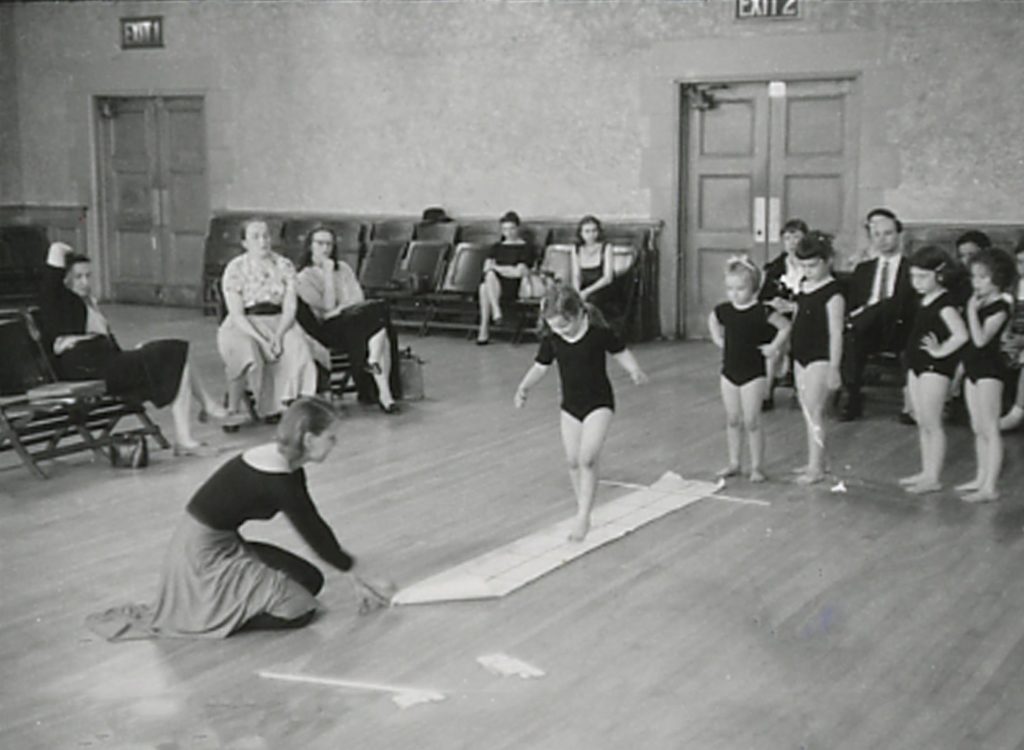
Ann Guest having children interpret Labanotation symbols by dancing the sequence of movement concepts she had notated for them. Picture from lodcus.org.
Dr. Guest further explains her quest for and ultimate codification of the primary movement verbs in the Introduction to the 2nd edition of Your Move: The Language of Dance® Approach to the Study of Movement and Dance, co-authored by Dr. Tina Curran, co-founder of the LODC USA (This text is available from the lodcusa.org). Dr. Guest writes:
From experiences as a dancer and dance educator, I recognized that no logical list of prime actions had ever been codified on which all dance (and other movement) is based. In painting, there are three prime colors, in western music, the octave – what exists for dance? This question led into an investigation lasting many years. My background of study in ballet, modern dance (European and American), and various [cultural] forms provided me with a broad view of dance, and my work with the system of recording movement, Labanotation, provided the tool through which findings could be pined down. The results of this research were the establishment of the Prime Actions and Movement Concentrations presented in the Language of Dance Movement Alphabet and the development of the Movement Family Tree (Guest and Curran, xxxiii-xxxiv).
LANGUAGE OF DANCE ACTIVITIES TO USE IN YOUR PRACTICE
How is Language of Dance used to teach movement in a wholistic child-centered way? I will provide three activities that readers can use with their students. I have adapted them from the Language of Dance Warmup and Toolkit developed by Dr. Teresa Heiland with the assistance of Kaitlyn Whitaker for use in the Language of Dance® Master Practitioner Certification course. The Movement Building Block Flashcards used in the Movement Alphabet Warmup and Identification Game can be purchased from lodcusa.org, Shop.
- Movement Alphabet Warmup. This type of warmup is suitable for any level, age group, and environment. It utilizes dancing and listening to build movement vocabulary, body/mind comprehension about each concept, and promotes interactions with others in the group. Allow 15-25 minutes.
- Goal: Experience each Movement Alphabet concept through moving and connecting visually to the symbolic representation.
- Outcomes: Build awareness of body, mind, and spirit by experimenting with the movement possibilities inherent in each Movement Alphabet concept and identifying the movement experience with the symbolic representation of each concept.
- Description: Place the Movement Building Block Flashcards along a wall. They stand up by themselves. The leader guides the warmup by showing each flashcard while saying its name. The leader offers functional and expressive examples of movements associated with each concept along with images and metaphors. The dancers investigate each concept presented by exploring movements sparked by the examples, images, and their own movement responses. Students review the symbolic representations of the concepts experienced by drawing the concept in the air while embodying the concept in movement.
- Variations:
- Selecting specific Movement Alphabet concepts can prepare dancers to focus their attention to warmup for a technique, composition, or repertory class in which those concepts appear more prominently.
- Asking dancers to relate to one another during the warmup by being aware, addressing. or being near another dancer builds a supportive network.
-

Score Interpretation activity score, “Travel, Shape, Stillness” created and notated by
Susan Gingrasso for this article.Formative Assessment:
- Identifying: Students identify each concept by saying the name of the concept while doing the movement.
- Reflecting: Students draw two Movement Alphabet concepts on separate pieces of paper. Each reflects on new discoveries about moving that concept as well as images and/or feelings that arose while moving. Students may share or discuss their reflections.
- Identification Game. This type of activity supports technique and improvisation classes. Dancers need to be able to identify and embody each Movement Alphabet concept used in the game. It can be one with pairs, small groups, or the whole class of dancers from any age, group or setting. It utilizes dancing, speaking, and reading to build movement vocabulary, body/mind comprehension about each concept, and promotes interactions with others in the group. Allow from 25-40 minutes for the activity and additional 20-30 minutes for the formative assessment.
- Goal: Develop collaboration and communication skills in a positive, engaging movement-rich environment.
- Outcomes: Collaborative team building community with strong communication skills and LOD concept observation and identification skills.
- Description: Create one or two teams (observers and performers). One person shows a Movement Alphabet concept card (without looking at it) to the performers. The performing team has to demonstrate the concept in a variety of ways until the person holding the card or observer team identifies the concept being performed.
- Variations:
- The card holder selects two concepts (without looking at them) placing one on top of the other. The card holder shows this two-movement sequence to the performing team whose members improvise three two-movement sequences. Team members need to separate each sequence by 2-3 seconds of stillness. The observing team sees if they can identify each of the concepts in the sequence accurately.
- The card holder asks the performers to apply one variable to their movement response: speed, size, level, facing, or energy. The observers identify the concept, the variable, and how the variable changed their knowledge about and understanding of the concept(s).
- Formative Assessment:
- Building short-term memory: The card holder places each card (or two cards), face down, on the floor after use. Observers and performers write the concepts presented in order on post-it notes at the end of the game. They (1) compare their remembered sequence with the order of the cards presented and (2) place the post-it notes in the same order and improvise a study based on those concepts.
- Metacognitive reflection: Participants describe, as best as they can, their approach to identifying the concept(s) seen or observed, generating performing their movement solutions clearly kinesthetic sensations experienced in observing, and ways that the variable changed improvising and identifying.
- Score Interpretation. This type of activity supports technique, composition, and repertory classes. Dancers will need to be able to identify and embody each Movement Alphabet concept in the score. This activity can be done with any age group, setting, or level. It utilizes dancing, listening, speaking, reading, and viewing to build movement vocabulary, understanding of structure, body/mind comprehension about each concept, fluency in creating and performing, and promotes interactions with others in the group. Allow from 40-60 minutes for the activity and another 20-30 minutes for the formative assessment.
- Goal: Interpret (read and perform) the Motif notated score to understand the importance of making and committing to movement choices, developing kinetic logic, and clarity in performance.
- Outcomes: Develop movement problem solving through the interpretation process and kinetic logic and commitment to choices made.
- Description: Work with a partner to develop two to three interpretations of the Motif notated score, Travel, Shape, and Stillness shown above. Embody each interpretation with a different character or performance motivation. Share your interpretations with others.
- Variations:
- Theme and Variation: Interpret the score to create a theme. Create three more interpretations, applying one variable to each; level, energy, size, facing, type of path chosen (straight, zig-zag, curved, circular, or random), direction of path (forward, backward, sideward), or how path is performed (on the feet, changing supports, springing, or turning). Create a theme and variation study that begins with the main study (the theme) followed by variations 1, 2, and 3. End by repeating the main study.
- Duet: Each partner creates 2-3 interpretations of the score. Stage your interpretations with your partner to create a duet. Investigate where to relate to one another by addressing, being near, or making contact.
- Formative Assessment:
- Kinetic logic: Discuss the role of kinetic logic in making movement choices and transitions between the main movements. Discuss ways that making movement choices assisted or challenged committing to a fully embodied performance.
- Compare and contrast: Identify the differences in each of your interpretations. Compare how each interpretation was similar or different from others you observed. Identify specific ways interpretations were similar to and different from one another. Discuss what you learned from comparing and contrasting choices made using the same material as a starting point.
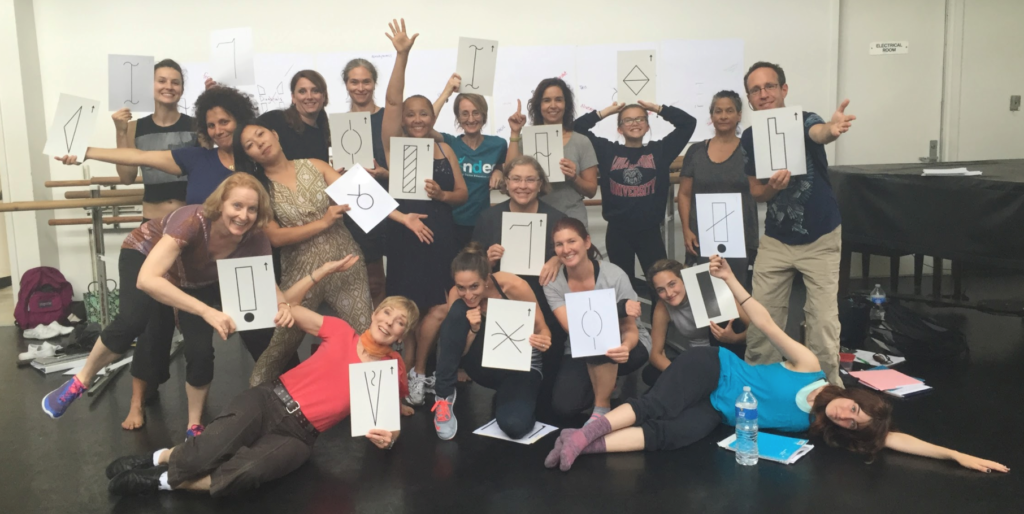
The 2016 LOD Foundations Part 2 class celebrating the end of their coursework held at Loyola Marymount University at Los Angeles.
I hope you enjoy trying these three examples with your dancers. As you will discover, the Language of Dance’s pedagogical learner-centered approach develops each child’s creative and critical thinking skills. Experiencing each Movement Alphabet concept aids each child to a develop deeper connection to movement when the movement experience and the actual movement symbol are linked together. Using dance-based symbols promotes problem solving and builds confidence, self-expression, and the ability to articulate and own movement choices.
Applying the Language of Dance conceptual and pedagogical framework to teaching and learning dance promotes dance literacy.
If you want to delve into Language of Dance, I invite you to join us in 2021 for the LOD Foundations professional development courses. You will dance into the theory and pedagogy of LOD Movement Alphabet and Motif notation by sensing, observing, reflecting, identifying interpreting, notating, creating, and applying. Depending on the state of the COVID-19 pandemic in the spring and summer of 2021, the LODC will offer course work as a hybrid of virtual and in person or all virtual. Graduates will be eligible to apply their work in their practice and continue their LOD studies with the LOD Master Teacher Trainers. Contact Susan Gingrasso, Associate Director for the Language of Dance Center, sgingrasso@lodcusa.org or visit lodcusa.org, Training for further information.
REFERENCES
Guest, Ann Hutchinson and Tina Curran. 2008. Your Move: The Language of Dance® Approach to the Study of Movement and Dance. 2nd ed. New York, NY: Routledge Taylor & Francis Group.
Heiland, Teresa. 2020. “LOD Warm up & LOD Toolkit Assignment.” Language of Dance Master Practitioner Certification course, 2019-2020.
Origins, Language of Dance Center website, lodcusa.org (accessed 8/229/2020).
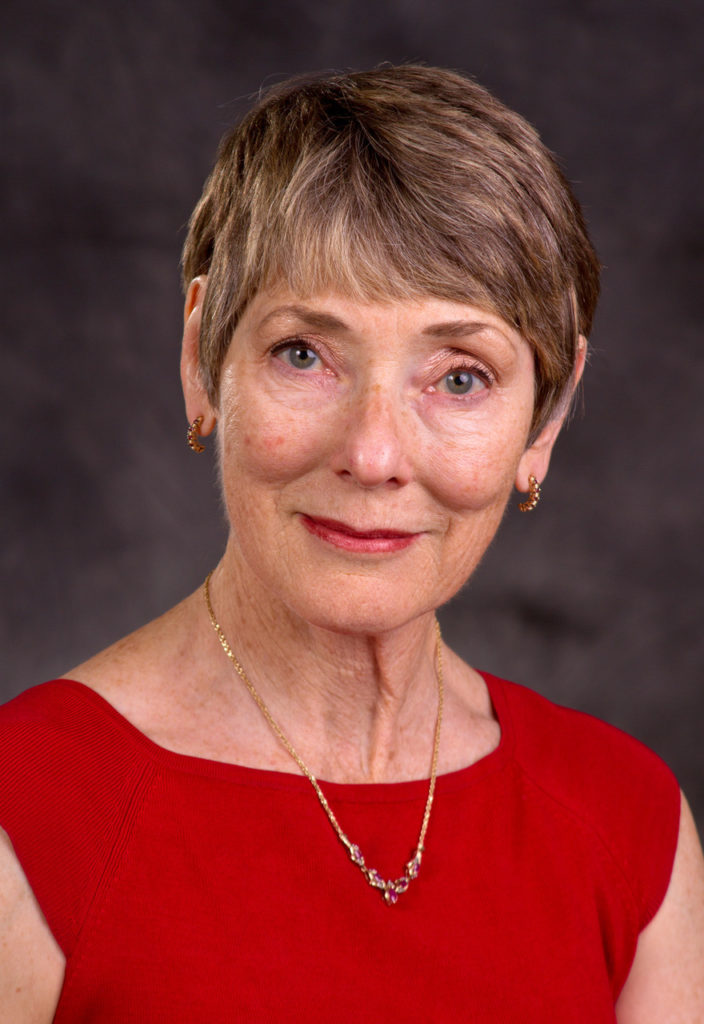 Susan Gingrasso, MA, Certified Movement Analyst (CMA), Language of Dance® Certification Specialist and Professor Emeritus, University of Wisconsin-Stevens Point Theatre & Dance Department where she brought the dance program to state and national prominence through her vision and leadership. She used LOD and LMA to teach technique, history, movement theory and analysis, composition and pedagogy. Gingrasso has taught LOD courses since 2004 after she completed her Stage 3: LOD Applications course.
Susan Gingrasso, MA, Certified Movement Analyst (CMA), Language of Dance® Certification Specialist and Professor Emeritus, University of Wisconsin-Stevens Point Theatre & Dance Department where she brought the dance program to state and national prominence through her vision and leadership. She used LOD and LMA to teach technique, history, movement theory and analysis, composition and pedagogy. Gingrasso has taught LOD courses since 2004 after she completed her Stage 3: LOD Applications course.
As the Associate Director for the Language of Dance Center, Susan helps administer the organization, secure locations for Foundations courses, design and teach course curricula, and expand ways to invite dance educators into the amazing world of Dance Literacy through the LOD Movement Alphabet and Motif notation. She writes the symbol of the month for the LODC site and submits quarterly articles for the Wisconsin Dance Council and the California Dance Education Association about using LOD in practice.
Gingrasso received the 2016 NDEO Outstanding Dance Educator Award in Higher Education and served as Director of Resources Review from 2008-2016. As the Associate Editor for Dance Education in Practice, she writes the Practical Resources for Dance Educators column. She co-chaired NDEO’s Applied Strategic Plan Taskforce (2015-2016) with President Rick Southerland and is chairing the Priorities Brochure Taskforce to bring NDEO’s Priorities for Dance Education into brochure form for the 2017 San Antonio conference.
